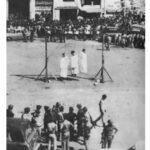
The Semiramis Hotel attack in Damascus.
On Sunday the 26th of September 1976 four Palestinian guerrillas from “The Black June” terror group opposed to Syria’s intervention in Lebanon, seized a hotel and 90 hostages at the Hotel Semiramis in downtown Damascus.
The government reported that the leader of the guerrillas and four hostages, of whom three were women, were killed. In the battle with Syrian troops, three guerrillas were captured and 34 of the hostages were wounded. The siege began around dawn and lasted until just before noon.
Several rooms in the hotel, one of the capital’s most comfortable and a favorite of foreigners, were destroyed.
Radio Damascus reported that the three terrorists were hanged in public in front of the hotel at dawn on Monday the 27th of September 1976. The men were identified as Muhammad al‐Barqawi, a Palestinian, Mouatassem Muhammad Ahmad Jayyoushi, also a Palestinian, and Jabbar Darwish, an Iraqi.
According to official Government reports, they had admitted to affiliations with Al Fatah, the strongest group within the Palestine Liberation Organization. All were dressed in white robes with details of their crime written on large sheets of paper pinned to them.
The bodies were left hanging for six hours.
Semiramis Hotel bombing
An attack was carried out by the Jewish paramilitary group Haganah on the Christian-owned Semiramis Hotel in the Katamon neighborhood of Jerusalem during the 1947–1948 Civil War in Mandatory Palestine.
After suspecting that the Semiramis hotel was one of two Arab headquarters in Katamon, the Haganah planted a bomb there on the night of 5–6 January 1948. The mission was carried out by a team consisting of four men supported by ten riflemen. The explosion killed 24 or 26 civilians including at least one child.
Among the dead were seven members of the Aboussouan family and Hubert Lorenzo, the 23-year-old son of the proprietor. The Spanish vice-consul, Manuel Allende Salazar, was also killed in the attack.
According to Associated Press reported at the time that a Haganah spokesman said the Jerusalem hotel was attacked because “the building was an important meeting place of Arab gangs, where arms were distributed to villages in the Jerusalem area.” He continued, “Unfortunately, we cannot hit at the Arab band’s (main) headquarters as it is secreted in a mosque.”
The attack was harshly condemned by the British authorities, and David Ben-Gurion sacked Mishael Shaham, the Haganah officer responsible for the Jerusalem sector, replacing him with David Shaltiel. According to John B. Quigley, the hotel was not a military headquarters and the British authorities denounced the attack as the “wholesale murder of innocent people.” Prior to the bombing, the distinctive white jeep of Abd al-Qadir al-Husayni, commander of Jerusalem’s Arab forces, had been seen in the hotel driveway.
In O Jerusalem!, Dominique Lapierre and Larry Collins write that Mishael Shaham, the Haganah leader who organised the bombing, had been sent to Jerusalem to stop the flow of beleaguered Jews retreating from mixed areas of Jerusalem to the Jewish areas. It was thought that ‘a major blow in Arab Katamon … might force the Arabs out of the quarter and change the psychological climate in the city’. Shaham asked “Where is the main Arab headquarters?”










Leave a Reply